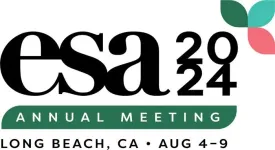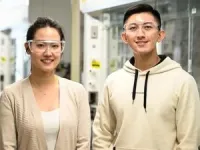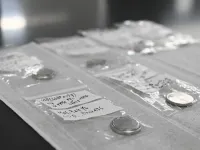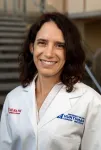(Press-News.org) The latest ecological research will be on full display at the Ecological Society of America’s upcoming Annual Meeting in Long Beach, California, Aug. 4–9. A focal point of the conference, symposia consist of four 20-minute talks organized around a central theme of broad interest. These sessions consider topics from different angles, integrate multiple lines of evidence and offer new insights on ecological phenomena.
This year, Annual Meeting symposia will address nonmaterial (“cultural”) ecosystem services, nature-based solutions to problems like stormwater runoff and urban heat, conserving soil biodiversity, harnessing AI for ecology and much more.
ESA invites staff journalists, freelance journalists, student journalists and press officers to register for free as media attendees up to and throughout the week of the Annual Meeting. For eligibility information, please visit ESA’s press registration credential policy page.
Members of the media will have access to all scientific sessions at the conference and to a press room where they can enjoy refreshments, internet access, a printer and an interview area. A virtual registration option is also available. Virtual attendees will have access to 13 livestreamed hybrid sessions as well as a variety of on-demand virtual content that will be available on the meeting platform until summer 2025.
Monday, August 5
1:30 PM –
3:00 PM
The Importance of Ecology in Cultural Ecosystem Services
Presenters: Alejandra Echeverri, UC Berkeley; Alohi Nakachi, University of Hawaii; Rachelle Gould, University of Vermont; Katherine Hernandez, UCLA; Tomas Ibarra, University of Chile
Rm 101A
3:30 PM –
5:00 PM
Translating Ecological Science to Address Nature-Based Regulatory and Non-Regulatory Performance Goals in the Built Environment
Presenters: Tim Nuttle, Oikos Ecology LLC; Lis Nelis, Ramboll; Kelly Farrell, Sasaki; Gabriel Thoumi, Responsible Alpha
Grand Ballroom B
Tuesday, August 6
10:00 AM –
11:30 AM
Disentangling the Branches of Open Science
Presenters: Bruno Soares, University of Regina; Cibele Amaral, CU Boulder; James Rattling Leaf, CU Boulder; Yo Yehudi, Open Life Sciences; Sasha Reed, U.S. Geological Survey; Elsa Culler, CU Boulder
Rm 104C
10:00 AM –
11:30 AM
Threats to Soil Biodiversity and the Urgent Need for Conservation
Presenters: Leena Vilonen, Colorado State University; Zoe Lindo, University of Western Ontario; Daniel Rath, NRDC; Kelly Ramirez, University of Texas, El Paso
Grand Ballroom B
3:30 PM –
5:00 PM
Nuestra Comunidad: The Role of Latin American Networks in Supporting Ecologists Throughout Their Careers
Presenters: Shersingh Tumber-Dávila, Dartmouth College; Diogo Provete, Universidade Federal de Mato Grosso do Sul; Coral del Mar Valle-Rodriguez, Cornell University; Elvira D’Bastiani, UCLA; Laura Jiménez, University of Chile; Daniel Stanton, University of Minnesota
Grand Ballroom A
Wednesday, August 7
1:30 PM –
3:00 PM
AI and Biodiversity Change: Key Challenges and Future Directions in Ecology and Computer Science
Presenters: Justin Kitzes, University of Pittsburgh; Sara Beery, Massachusetts Institute of Technology; Marta Jarzyna, Ohio State University; David Rolnick, McGill University
Rm 104A
1:30 AM –
3:00 PM
Searching for Rules Governing Community Dynamics
Presenters: Daliang Ning, University of Oklahoma; Mengting Yuan, UC Berkeley; Christopher Heggerud, UC Davis; Jizhong Zhou, University of Oklahoma; Pedro Peres-Neto, Concordia University; Jennifer Martiny, UC Irvine; Stephan Munch, UC Santa Cruz
Grand Ballroom B
3:30 PM –
5:00 PM
Timing of Environmental Exposures, Individual Lives and Population Dynamics
Presenters: Raisa Hernandez Pacheco, Cal State Long Beach; Shripad Tuljapurkar, Stanford University; Pat Monaghan, University of Glasgow; Jean-Michel Gaillard, University of Lyon & CNRS; Sha Jiang, Stanford University
Grand Ballroom A
Thursday, August 8
10:00 AM –
11:30 AM
Unpacking the Effects of Plant Diversity on Insect Communities Across Ecosystems
Presenters: Katherine Holmes, Binghamton University; Carmen Blubaugh, University of Illinois; Diego Salazar Amoretti, Binghamton University; Philip Hahn, University of Florida; Bastien Castagneyrol, INRA; Paul Pauchon, Alliance Bioversity-CIAT; Andrea Glassmire, Louisiana State University
Grand Ballroom A
1:30 PM –
3:00 PM
Urban Ecology in a Biological and Cultural Diversity Hotspot: From Testing Theories to Improving Wellbeing in Greater Los Angeles
Presenters: Dustin Herrmann, TreePeople; Lara Roman, US Forest Service; Natalie van Doorn, US Forest Service; Morgan Rogers, UCLA; Kirsten Schwarz, UCLA; Darrel Jenerette, UC Riverside; Kat Superfisky, City of Los Angeles; Talia Dotson, TreePeople; Edith de Guzman, UCLA
Rm 104C
3:30 PM –
5:00 PM
Emergent Coexistence in Microbial Communities and Beyond
Presenters: Zachary Miller, Yale University; Chang-Yu Chang, University of Pennsylvania; Hyunseok Lee, Massachusetts Institute of Technology; Alejandra Rodriguez Verdugo, UC Irvine
Rm 101A
On-site Press Room
Location: Room 203A, Long Beach Convention Center, 300 E Ocean Blvd, Long Beach, CA 90802
Press Room hours:
Sunday, August 4: 12:00 pm – 5:00 pm
Monday, August 5: 7:00 am – 5:00 pm
Tuesday, August 6: 7:00 am – 5:00 pm
Wednesday, August 7: 7:00 am – 5:00 pm
Thursday, August 8: 7:00 am – 5:00 pm
Phone number: (562) 499-7731
###
The upcoming ESA Annual Meeting will take place August 4–9 in Long Beach, California, and will feature hundreds of oral and poster presentations on the latest ecological science. Learn more on the meeting website. ESA invites press and institutional public information officers to attend for free. To register, please contact ESA Public Affairs Manager Mayda Nathan directly at gro.ase@adyam. On-site registration and virtual registration (providing access to the entire program and a limited number of hybrid sessions) are also available.
###
The Ecological Society of America, founded in 1915, is the world’s largest community of professional ecologists and a trusted source of ecological knowledge, committed to advancing the understanding of life on Earth. The 8,000 member Society publishes six journals and a membership bulletin and broadly shares ecological information through policy, media outreach and education initiatives. The Society’s Annual Meeting attracts 4,000 attendees and features the most recent advances in ecological science. Visit the ESA website at https://www.esa.org
Follow ESA on social media:
Twitter/X – @esa_org
Instagram – @ecologicalsociety
Facebook – @esa.org
END
UNIVERSITY PARK, Pa. — Rechargeable solid-state lithium batteries are an emerging technology that could someday power cell phones and laptops for days with a single charge. Offering significantly enhanced energy density, they are a safer alternative to the flammable lithium-ion batteries currently used in consumer electronics — but they are not environmentally friendly. Current recycling methods focus on the limited recovery of metals contained within the cathodes, while everything else goes to waste.
A team of Penn State researchers may have solved this issue. Led by Enrique Gomez, interim associate dean for equity and inclusion and professor of chemical engineering ...
UNIVERSITY PARK, Pa. — Biodegradable electronics allow for medical devices — such as drug delivery systems, pacemakers or neural implants — to safely degrade into materials that are absorbed by the body after they are no longer needed. But if the water-soluble devices degrade too quickly, they cannot accomplish their purpose. Now, researchers have developed the ability to control the dissolve rate of these biodegradable electronics by experimenting with dissolvable elements, like inorganic fillers and polymers, that encapsulate the device.
The team, led by Huanyu “Larry” Cheng, the James L. Henderson, Jr. Memorial Associate Professor ...
URBANA, Ill. – Raw poultry is one of the main causes of Salmonella poisoning, which affects thousands of people in the U.S. every year. A new study from the University of Illinois Urbana-Champaign shows that few products with high levels of very virulent Salmonella strains are responsible for most of the illnesses from raw chicken parts. The researchers suggest regulation efforts should focus on detecting and preventing those types of high-risk contamination.
“Over the last 20 years, the poultry industry has done a really good job of lowering the frequency of Salmonella in poultry. However, the number of people ...
By Maddie Johnson
University of Arkansas System Division of Agriculture
Arkansas Agricultural Experiment Station
FAYETTEVILLE, Ark. — While half the global population relies on rice as a staple, about 15 percent of rice produced each year is contaminated by potentially fatal aflatoxins. Seeing this threaten lives in her home country of Kenya prompted a graduate research assistant to focus on eradicating the risk through safer storage methods.
Faith Ouma, a Ph.D. student in the food science department at the University of Arkansas, was the lead author of “Investigating safe storage conditions to mitigate aflatoxin contamination in rice.” It was published ...
Embargoed for release until 5:00 p.m. ET on Monday 15 July 2024
Annals of Internal Medicine Tip Sheet
@Annalsofim
Below please find summaries of new articles that will be published in the next issue of Annals of Internal Medicine. The summaries are not intended to substitute for the full articles as a source of information. This information is under strict embargo and by taking it into possession, media representatives are committing to the terms of the embargo not only on their own behalf, but also on behalf of the organization they represent.
----------------------------
1. ...
An “unconventional” immune response now identified by scientists from the Hackensack Meridian Center for Discovery and Innovation (CDI) is a potential new pathway for developing new vaccines for tuberculosis (TB), according to a new publication.
Marginal zone B (MZB) cells are a natural response to TB infection which has been long overlooked - and which might be a welcome new target that could be bolstered through new vaccines to better combat and prevent the disease, according to the new publication in the journal Cell Reports.
“Our results indicate that B cells skew their immune landscape ...
Michelle Mendoza, PhD, researcher at Huntsman Cancer Institute and associate professor of oncological sciences at the University of Utah (the U) and Jeffrey Weiss, PhD, professor of biomedical engineering and faculty member in the Scientific Computing and Imaging Institute at the U, are the recipients of a $2.6 million grant from the National Institutes of Health (NIH) to research how tension in lung tissue affects the growth and distribution of tumors. This innovative approach could uncover new mechanisms for understanding how lung cancer develops.
“There ...
Narcissistic CEOs that also serve as chair of the board are adept at controlling how their boards of directors focus their attention, giving the CEO the ability to get their way. A new study published in the Strategic Management Journal found that by driving board discussions about risk-taking to hold a positive tone, narcissistic CEOs can allocate more resources toward risk-taking strategies. The findings deepen our understanding of how CEO behavior and personality types can drive risk management strategies.
The research team — Christopher S. Tuggle of the University of Central Arkansas, Cameron J. Borgholthaus of the University of Wyoming, Peter D. Harms of the University of Alabama, ...
Sickle cell disease is the most common inherited red blood cell disorder in the United States and can lead to health problems including organ dysfunction, acute chest syndrome and strokes over a patient’s lifespan. According to a new study, individuals living with sickle cell disease who experience a delay of more than six months after transferring from pediatric to adult care are twice as likely to be hospitalized compared to those who transition in less than two months.
In the study, Kristen ...
Overall rates of long-term survival following stroke are improving, but Black individuals experience worse long-term outcomes compared to white individuals, according to University of Cincinnati research published online July 15 in Neurology®, the medical journal of the American Academy of Neurology.
UC’s David Robinson, MD, corresponding author on the research, said prior studies had examined short-term stroke outcomes of 30 or 60 days, but this time the team looked at survival rates five years past a person’s stroke.
“This was ...







